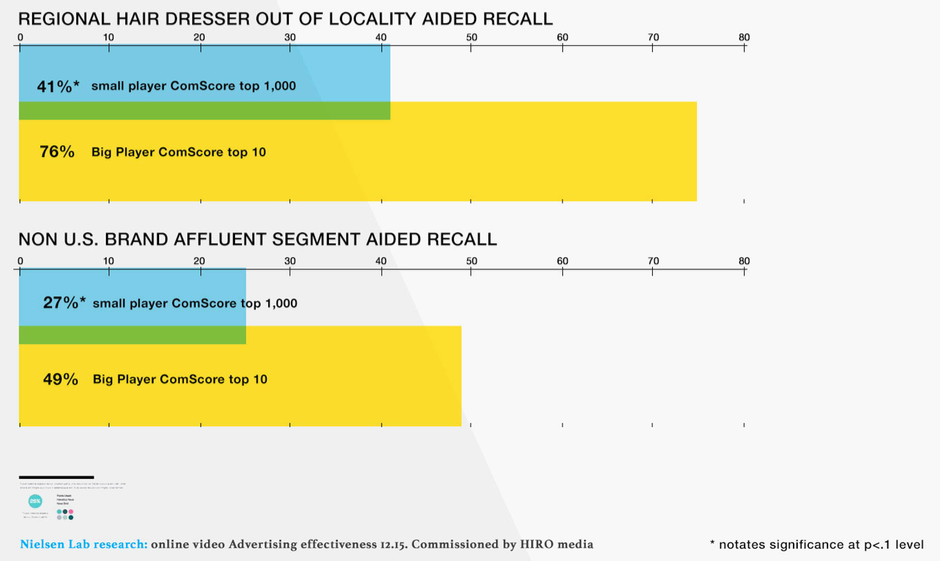Media
The Truth About the ROI of Online Video Ads, in 5 Charts
Your video ad metrics are likely failing you—at least when it comes to helping you understand ROI.
A new study from the Nielsen Media Lab and HIRO Media suggests that there’s hardly any correlation between engagement-based metrics (like click-through rates and views) and ROI (intent to purchase). So while it might be nice to brag that your Facebook video got a million views, those views still don’t tell you how many people remembered the ad or decided they wanted to buy your product.
It shouldn’t be surprising, then, that 43 percent of marketers say they have difficulty proving the ROI of their online video ads, according to an eMarketer report. Without knowing how to show business results, it’s difficult for marketers to optimize going forward.

To help out, Nielsen looked at three non-engagement-based metrics and studied how they affected consumer behavior:
1. Player size: small (300 x 250) vs. big (640 x 360)
2. Content environment: content relevant to target audience vs. non-relevant
3. Site ranking: comScore top 1000 vs. comScore top 10
Here’s what Nielsen found.
1. You might be burning your budget
Brands can shell out up to five times more money for big video players on sites in the comScore top 10, but Nielsen found that these factors had almost no impact on purchase intent. Perhaps marketers may be spending all that extra money for nothing.
This is especially true for “known brands,” which Nielsen defines as large brands like leading car manufacturers or cosmetics companies.

While there’s a slight difference in recall, it’s marginal given the amount brands spend for that tiny boost. As Nielsen notes, the difference in price can reach 500 percent while the effect on consumers is lower than five percent.
2. Bigger players reach non-target audiences
You might want your ads to reach a non-target audience in an effort to generate brand awareness. For instance, a brand may aim to get men looking at women’s cosmetic products during the holidays so they can purchase them as gifts. In that case, it does help to buy a larger video ad on a high-ranking site, as it increases overall recall.
3. Video size and site ranking can affect small brands
The size of the video player and site rankings can have a significant effect on ads run by “unknown brands,” such as niche brands and regional companies. For these brands, the bigger the video and more popular the site, the bigger the impact.

The report notes, “If you are unknown, you do need to shout in order to be noticed.” Specifically, Nielsen recommends first running a campaign in a big player across top sites. Then, once your brand gains recognition, you can move to a small player across a broader range of sites.
4. Digital video is still a lot like cable
Nielsen found that timelines for successful digital video advertising mirrors what marketers have been doing on TV for decades. When brands launch a new product, they’ll often start campaigning with longer ads on major networks. Once they gain recognition and blast their message, they’ll switch to shorter ads on more niche cable channels.
Following this logic, online video advertisers should start by running ads on big players across top 10 sites for two to four weeks. Then, they can switch to small players on top 1000 sites.
5. Content environment matters
Ads that were paired with relevant content to the target audience saw a 30 percent increase in consumer impact (such as recall and purchase intent) compared to ads that were placed with irrelevant content or content that didn’t appeal to the target demographic.

As outlined in this chart from Nielsen, content relevance seems to have the biggest impact on automative and sports-oriented ads. The blue bars show the impact of ads surrounded by relevant content, and the yellow bars show the impact of ads surrounded by content that didn’t interest the target audience.
While marketers still struggle to find metrics that correlate with ROI, this research should help them allocate their budgets more effectively and make smarter decisions about ad format and placement.
Image by GettyGet better at your job right now.
Read our monthly newsletter to master content marketing. It’s made for marketers, creators, and everyone in between.




